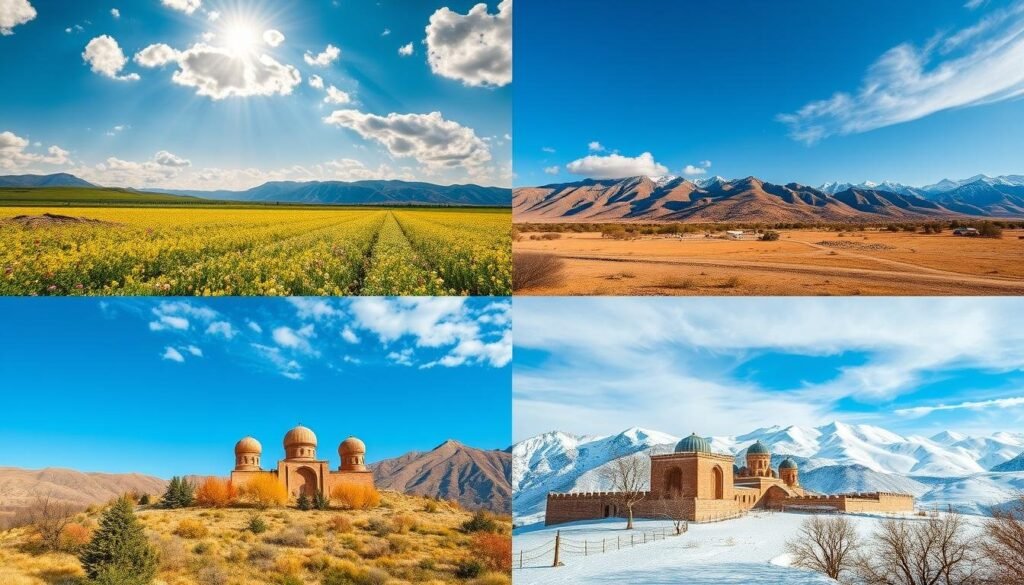Weather and Seasonal Changes in Uzbekistan: Student Guide
Uzbekistan’s weather patterns and seasonal changes are crucial for students to understand. The country offers diverse climatic conditions that impact daily life and studies. Let’s explore what makes Uzbekistan’s weather unique and how to adapt to it.

Uzbekistan, similar in size to Sweden or California, has an extreme continental climate. Temperature and precipitation vary greatly throughout the year. The country experiences scorching summers and freezing winters.
This guide will explore Uzbekistan’s climate in detail. We’ll uncover the secrets behind its seasonal changes. You’ll learn to navigate the weather like a local during your stay.
Overview of Uzbekistan’s Climate
Uzbekistan boasts an arid climate with plenty of sunshine and little rain. The country averages just 8 inches of yearly rainfall. This unique weather mix greatly affects daily life for residents and students alike.
General Climate Characteristics
Uzbekistan’s weather swings from scorching summers to frigid winters. Temperatures can plummet to -35°C (-31°F) in winter. Summers can sizzle at up to 45°C (113°F).
This extreme temperature range creates a challenging yet intriguing environment. Residents must adapt to these dramatic seasonal changes.
Importance of Knowing the Weather
Students benefit greatly from understanding Uzbekistan’s weather patterns. This knowledge helps them plan daily activities and travel more effectively. It also guides decisions on clothing and outdoor study opportunities.
Key Climate Zones in Uzbekistan
Uzbekistan features several distinct climate zones. These range from arid deserts in the south to mountainous regions in the east. The country’s diverse landscape contributes to varied weather conditions across different areas.
Students should familiarize themselves with these climate zones. This preparation will help them navigate regional weather differences during their time in Uzbekistan.
Seasonal Changes in Uzbekistan
Uzbekistan has four distinct seasons, each with its own charm. The country’s landscapes change with the weather, offering students a captivating experience. From spring blossoms to snowy winters, Uzbekistan’s climate is diverse and fascinating.
Spring: A Time of Blossoms
Spring arrives in Uzbekistan between April and June. Tashkent sees mild temperatures from 41°F to 72°F. Rainfall ranges from 10 mm to 56 mm, helping plants thrive.
Desert blooms come to life during this season. The lush vegetation creates a beautiful landscape for visitors to enjoy.
Summer: Heat and Sunshine
Summers in Uzbekistan are hot and sunny. Tashkent’s temperatures can reach 96°F from June to August. There’s little to no rainfall, making it perfect for outdoor adventures.
The arid climate allows for great trekking opportunities. Visitors can explore the country’s diverse landscapes under clear skies.
Autumn: Harvest and Colorful Landscapes
Autumn brings cooler weather to Uzbekistan. Tashkent’s temperatures range from 41°F to 67°F in October. Rainfall increases to 19-36 mm from September to November.
Agricultural regions celebrate their bountiful harvest. The landscape turns vibrant with autumn colors, creating a picturesque scene.
Winter: Cold and Snowy Winters
Winters in Uzbekistan are cold. The plains see average highs of 28°F in December. Monthly precipitation is around 36 mm.
Mountain areas can get as cold as -18°F. Snow blankets the landscape, turning it into a winter wonderland.
Climate change has affected Uzbekistan’s seasons. Summers are hotter and drier, while winters are colder and longer. Understanding these changes helps students plan activities and pack appropriately.
Daily Weather Patterns
Uzbekistan boasts diverse weather patterns that change across regions and throughout the day. These trends greatly affect daily life for locals and tourists. Understanding the climate helps people plan their activities better.
Average Temperature Ranges
Uzbekistan’s temperatures can swing wildly. Summer highs often top 40°C (104°F), while winter lows can plummet below -35°C (-31°F) in some areas.
Tashkent, the capital, typically sees temperatures between -1°C (30°F) and 17°C (63°F). In the southern city of Termez, the range is 5.5°C (42°F) to 31°C (88°F).
Precipitation Trends
Uzbekistan generally receives little rainfall. Most precipitation occurs in winter and spring. The amount varies greatly across the country.
Tashkent gets about 460 mm (18 inches) of rain yearly. Bukhara, in the west, only sees 130 mm (5 inches) annually. Mountain regions tend to be wetter than desert areas.
Wind Patterns and Their Effects
| Location | Average Wind Speed | Prevailing Wind Direction |
|---|---|---|
| Tashkent | 8-12 km/h (5-7 mph) | NNW |
| Samarkand | 10-15 km/h (6-9 mph) | ENE |
| Bukhara | 12-16 km/h (7-10 mph) | W |
Winds in Uzbekistan greatly influence daily weather, especially in desert regions. Average speeds range from 8 to 16 km/h (5 to 10 mph). Wind directions vary across different parts of the country.
Popular Weather-Related Events for Students
Uzbekistan’s diverse climate shapes a vibrant calendar of events throughout the year. Students can immerse themselves in the country’s rich culture and traditions. Each season brings captivating festivities for students to explore and enjoy.
Spring Festivals and Activities
Uzbekistan celebrates spring with lively festivals as the desert bursts into bloom. Students can join the Navruz festival, marking the Persian New Year and vernal equinox. They’ll enjoy traditional music, dance, and cuisine at this event.
The mild spring climate is perfect for hiking and outdoor activities. Students can appreciate Uzbekistan’s natural beauty while exploring the countryside.
Summer Outdoor Events
Uzbekistan’s sunny summers provide an ideal backdrop for outdoor activities and events. Students can go trekking and mountain climbing in the country’s picturesque regions. They can also attend cultural festivals in cities like Samarkand and Bukhara.
These events showcase vibrant music, dance, and culinary traditions. Students will get a taste of Uzbek culture during these summer celebrations.
Autumn Cultural Celebrations
Autumn in Uzbekistan brings cooler weather and a landscape of vibrant colors. The country celebrates the harvest season with various cultural events. Students can join the Silk and Spices Fair in Samarkand.
This fair lets students explore Uzbekistan’s rich history, art, and handicrafts. The mild autumn climate is perfect for visiting historic cities and monuments.
These weather-related events offer students a unique experience of Uzbekistan’s seasonal changes. They also provide insight into the country’s culture and traditions. Students will gain a deeper appreciation for Uzbekistan through these activities.
Dressing for the Weather
Uzbekistan’s climate varies greatly. Packing the right clothes is crucial. Your comfort depends on dressing for the weather.
Recommended Clothing for Each Season
Summers can be scorching, reaching 40°C. Choose lightweight fabrics like cotton and linen. T-shirts, shirts, and comfortable pants or shorts work well.
Flip-flops or light trainers are perfect for sunny days. In colder months, layering is key. Wool sweaters, scarves, and warm coats are must-haves.
Winters can plummet to -30°C. Sturdy boots and gloves will protect you from chilly winds and snow.
Tips for Layering in Transitional Weather
- Invest in versatile pieces that can be easily layered, such as lightweight jackets, cardigans, and long-sleeved tops.
- Bring a variety of clothing options to accommodate the changing temperatures throughout the day.
- Carry a compact, water-resistant jacket or umbrella to protect against unexpected showers or sudden drops in temperature.
- Accessorize with items like hats, scarves, and gloves, which can be added or removed as needed.
Cities in Uzbekistan may have modern dress codes. Rural areas often maintain traditional attire. Respect local customs, especially at religious sites.
Cover your shoulders and knees when visiting religious places. This shows respect for local traditions.
Outdoor Study Tips
Uzbekistan’s diverse weather patterns offer unique opportunities for outdoor studying. Some seasons are better suited for outdoor learning than others. Knowing our local climate helps us plan effective outdoor study sessions.
Best Times for Outdoor Study Sessions
Spring and autumn in Uzbekistan provide ideal conditions for outdoor studying. Temperatures range from 15°C to 25°C (59°F to 77°F), perfect for focusing and enjoying nature.
Mild weather and longer days boost our productivity. We can make the most of these seasons to study outdoors effectively.
Ideal Locations for Enjoying Good Weather
Tashkent’s public parks and green spaces are great for outdoor studying. These peaceful areas offer lush surroundings, creating the perfect backdrop for learning.
During summer, we can study outdoors in early mornings or evenings. This helps us avoid the intense midday heat.
In winter, it’s best to study indoors where it’s warm and cozy. This ensures we stay comfortable and focused on our work.
| Season | Recommended Times for Outdoor Study | Ideal Locations |
|---|---|---|
| Spring | Mid-March to May | Parks, gardens, university campuses |
| Summer | Early morning, evening | Shaded areas, near water bodies |
| Autumn | September to November | Parks, university grounds, historic sites |
| Winter | Not recommended | Indoors, study spaces |
Choosing the right weather and locations enhances our outdoor study experiences. We can enjoy Uzbekistan’s beautiful landscapes while learning effectively.
Travel Considerations Based on Weather
Uzbekistan’s diverse climate offers unique experiences year-round. Understanding seasonal changes helps you plan your trip better. The weather greatly impacts your travel experience in this beautiful country.
Best Times to Visit Major Cities
Spring and autumn are ideal for visiting Uzbekistan’s major cities. These seasons offer mild temperatures between 15°C and 25°C. It’s perfect for exploring the country’s rich cultural heritage and outdoor attractions.
Weather Impact on Travel Plans
- Spring (March to May): Average daytime temperatures range from 15°C to 25°C, offering clear skies and perfect natural lighting for photography.
- Summer (June to August): Daytime temperatures often soar above 35°C in major tourist destinations, presenting extended opportunities for night-time exploration due to long daylight hours.
- Autumn (September to November): Comfortable temperatures ranging from 15°C to 25°C, ideal for exploring outdoor monuments and indoor attractions due to reduced tourist numbers.
- Winter (December to February): Temperatures can drop below freezing, especially at night, making it a less popular time for travel, but providing opportunities for ski enthusiasts and experiencing the country’s chilly weather in snow-capped areas.
Spring and autumn offer the best weather and prices for backpackers. These seasons are ideal for budget travelers too. The weather is pleasant and tourist crowds are smaller.
Luxury travelers should visit from late April to early June. September to October is also great for exploring Uzbekistan’s cultural wonders.
| Season | Typical Temperatures | Ideal for |
|---|---|---|
| Spring | 15°C to 25°C | Exploring southern and central regions, witnessing blooming flowers |
| Summer | 32°C and above | Budget-friendly travel, enjoying festivals like the Festival of Traditional Culture |
| Autumn | 12°C to 34°C | Visiting events like the International Ethnosport Festival and Shaq Taronalari |
| Winter | 0°C to 5°C | Skiing and experiencing the country’s chilly weather in snow-capped areas |
Weather Resources for Students
Students in Uzbekistan have many reliable weather resources at their disposal. These tools help them plan activities and travel with confidence. User-friendly apps and official meteorological services provide up-to-date weather information.
Apps and Websites for Real-Time Updates
Several weather apps and websites offer real-time forecasts for Uzbekistan’s regions. These platforms provide details on temperature, precipitation, wind, and humidity levels. Students can use this info to make smart decisions about their daily routines.
- The weather application covers major European cities in addition to cities in Uzbekistan, providing a wide range of weather forecasts for various locations.
- The app offers a 7-day weather report, giving users a detailed outlook of the upcoming week’s weather conditions.
- Users can view the current temperature and the “feels like” temperature, offering insights into how the weather may be perceived.
- The app provides data on temperature, humidity, probability of precipitation, and wind speed, aiding students in understanding weather patterns comprehensively.
- Darksky.net serves as the primary data source for weather information, ensuring reliability and accuracy in the forecasts.
- The app supports the display of temperatures in both Celsius and Fahrenheit, catering to a diverse range of users’ preferences.
- The user experience is a key highlight with an ergonomic design aimed at enhancing readability and providing a seamless weather information experience for students.
Local Meteorological Services
Students can also consult local meteorological services in Uzbekistan for detailed weather data. These services offer accurate forecasts for different regions of the country. This information helps students plan their activities and travel effectively.
Environmental Considerations
Uzbekistan faces big environmental challenges due to climate factors. The Aral Sea’s drying has changed local weather patterns. This leads to extreme weather events, droughts, floods, and unpredictable temperatures.
Climate Change Effects in Uzbekistan
Climate change impacts various sectors in Uzbekistan. Inefficient energy use costs the country 4.5 percent of its GDP annually. 80 percent of its water comes from outside, making it vulnerable to shortages.
Initiatives to Combat Weather-Related Issues
Uzbekistan has started initiatives to address climate change. The National Strategy on Biodiversity Conservation aims for sustainable resource management. The Green Economy Strategy targets renewable energy and resource efficiency.
The Environment and Climate Action Cluster develops gender-sensitive adaptation plans. These cover health, agriculture, water, and housing sectors. Uzbekistan also supports its Nationally Determined Contribution priorities.
These efforts show Uzbekistan’s dedication to fighting climate change. The country uses climate studies and weather data. It aims to build a sustainable future and address environmental concerns.
Tips for Staying Healthy in Varying Weather
Uzbekistan’s diverse climate can affect your health. With the right steps, students can stay healthy year-round. Let’s explore how to adapt to seasonal changes and enjoy this captivating country.
Managing Allergies in Spring
Spring in Uzbekistan brings blooming flowers and allergy challenges. High pollen counts can trigger sneezing and itchy eyes. Pack antihistamines and nasal sprays prescribed by your doctor.
Keep an eye on pollen forecasts. Limit outdoor time on high-pollen days. These steps will help you breathe easier during allergy season.
Hydration Tips for Hot Summers
Uzbekistan’s summers can be scorching, often exceeding 100°F (38°C). Staying hydrated is key to avoiding heat-related illnesses. Always carry a water bottle and sip regularly.
Avoid sugary or caffeinated drinks that can dehydrate you. Seek shade and wear light, loose clothing. Take breaks from the sun to beat the heat.
Winter Wellness Strategies
Uzbekistan’s cold, snowy winters require special health attention. Layer up with warm clothing for proper insulation. Eat a balanced, nutrient-rich diet to maintain energy and immune function.
Practice good hand hygiene to prevent illness. Be aware of respiratory diseases common in winter. These habits will keep you healthy during chilly months.
Adapting to Uzbekistan’s weather helps students stay healthy and energized. Embrace the climate challenges to fully enjoy this remarkable country’s vibrant culture. Make the most of your educational journey in Uzbekistan.
Fun Facts About Uzbekistan’s Weather
Uzbekistan’s diverse geography creates unique climate features across its regions. The country’s weather patterns vary from scorching deserts to cooler mountains. This diversity reflects Uzbekistan’s stunning landscapes.
Unique Climate Features of Different Regions
The Kyzylkum Desert in western Uzbekistan experiences extreme heat. Summer temperatures often exceed 40°C (104°F). The eastern Tien Shan mountains enjoy a more temperate climate with cooler temperatures.
These mountains also receive higher levels of precipitation. This regional diversity showcases the complexity of Uzbekistan’s weather patterns.
Record Weather Events in History
- Uzbekistan has seen record-breaking temperature fluctuations. Winter temperatures can drop as low as -40°C (-40°F) in some regions.
- Rare snowfall events have occurred in typically arid regions. These unusual occurrences captivate both residents and visitors.
- Violent storms with hail and high winds have been recorded. These events highlight the country’s dynamic weather conditions.
Uzbekistan’s climate features and weather events showcase its fascinating diversity. They offer insights into the interplay of geography, topography, and climate. Students and researchers can learn much from this Central Asian nation’s weather patterns.
Conclusion: Making the Most of Uzbekistan’s Weather
Uzbekistan’s diverse weather patterns offer unique experiences for students. Each season brings opportunities for cultural immersion and outdoor exploration. Students can fully appreciate the country’s natural beauty and rich heritage.
Embracing Seasonal Changes
Uzbekistan’s weather patterns create a tapestry of ever-changing wonders. Spring brings vibrant blossoms, while summers are sun-soaked and autumns feature colorful landscapes.
These seasonal changes allow for a wide range of activities and traditions. Students can attend lively spring festivals, enjoy outdoor summer adventures, and join autumn celebrations.
Encouragement to Explore the Outdoors
Uzbekistan’s varied climate and geography offer exciting outdoor exploration opportunities. Students can discover striking landscapes, from the majestic Tien Shan mountains to expansive arid plains.
Outdoor adventures provide more than just refreshing natural scenery. They deepen appreciation for Uzbekistan’s environmental challenges and conservation efforts.





